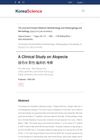TLDR Younger children with alopecia areata often experience more severe hair loss and longer illness, with allergies and nutrient deficiencies playing a role.
The study analyzed 304 pediatric patients with alopecia areata at Beijing Children's Hospital from 2010 to 2014, finding a male to female ratio of 1.3:1 and a peak onset age of 3 to 7 years. Severe alopecia areata was present in 61.8% of cases, with younger onset ages linked to more severe hair loss. Spring was the most common season for disease onset. Nail involvement occurred in 26.8% of cases, and 13.82% had allergic diseases. Abnormal trace elements, particularly zinc and iron deficiencies, were found in 64.1% of patients. The study concluded that younger onset age correlated with more severe hair loss and a longer disease course, highlighting the importance of considering allergic factors in pediatric alopecia areata.
 1 citations
,
October 2021 in “International Journal of Research in Dermatology”
1 citations
,
October 2021 in “International Journal of Research in Dermatology” Alopecia areata mainly affects men aged 21-40 and is linked to autoimmune issues, thyroid problems, and inflammation.
September 2020 in “Annals of Punjab Medical College” Alopecia areata in children is more common in boys, mainly affects the scalp, and is linked to genetics and psoriasis.
1 citations
,
February 2020 in “International Journal of Research in Dermatology” Scalp alopecia areata mostly affects young adult males, often starts suddenly, and usually presents as single, patchy lesions.
 4 citations
,
May 2013 in “The Journal of Korean Medicine Ophthalmology and Otolaryngology and Dermatology”
4 citations
,
May 2013 in “The Journal of Korean Medicine Ophthalmology and Otolaryngology and Dermatology” Korean medicine effectively treats febrile alopecia, shifting focus from genetic to febrile causes.
275 citations
,
November 2002 in “International Journal of Dermatology” Alopecia areata mainly affects young people and has significant psychological impacts, especially in males.
 1 citations
,
January 1996 in “The Journal of Korean Medicine Ophthalmology and Otolaryngology and Dermatology”
1 citations
,
January 1996 in “The Journal of Korean Medicine Ophthalmology and Otolaryngology and Dermatology” The study found that the most common symptom of alopecia was insomnia and the most used treatment was Shineung Yangjin Dan.



